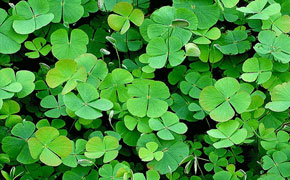How to Find a Four Leaf Clover?

Four-leaf clovers are known all around the world for giving the finder good luck and fortune. If you're feeling unfortunate or you just need a quick good-luck charm, you'll want to know how to find one. With searching strategies and a good eye, you'll find a four-leaf clover in no time at all. (The plants in the images are NOT clovers, they are Wood Sorrels).
Find a patch of clover. If you find a patch in which many of the plants have four leaves, it's probably a clover look-alike, such as Marsilea quadrifolia (leaves have a triangular shape with rounded corners, grows in wet soil and water) or Oxalis tetraphylla/deppei (purple in the center, where the four leaflets meet). What you want to look for is a patch of white clover (Trifolium repens, identified by white flowers) because they're more likely to produce a four-leaf plant than other types of clover.
Scan over the patch. When you are starting out, don't stare down every single clover. Brush over the clover gently with your foot so that you can see them all. This should catch the more conspicuous clovers. Your eyes will naturally go to the odd one out. If you find 3 or more in less than 3 minutes, you probably have a hot spot. Mark this place and visit it often, because the mutation will happen again. You can usually get 10 or so out of a well sized "hot spot" with close inspection.
Identify any four-leaf varieties. Most four-leaf clovers have one leaf that is smaller than the other three. Some leaves have white or red or no lines. The leaves can be rounded or heart-shaped.
Mark the patch! It is commonly thought that 4-leaf clovers are actually caused by a genetic defect in the root of the clover plant. Most clovers in patches are either growing from one plant or a network of plants. So, the chances are that if you've found one defected clover, there's likely to be more there. Place a small flag or something to mark it so you can check the rest of the areas.
If you want more of a good thing, gently remove a strand of the multi-leaf clover, about 4-5 heads worth, and set in in water in a place with indirect sunlight. When it starts growing roots, plant it in a clear area in your yard. It spreads fast, and the patch will have the same genetics as the original.
Pick the flowers from this clover once they turn brown. Store the seeds until the next spring, or refrigerate them. Plant them, and wait until each young plant has several dozen heads to determine whether it has the multi-leaf gene. I have been breeding for over twenty years, and my latest crop is up to about 30% (ie, 30% of the heads have multiple leaves).
Clover doesn't seem to do well in pots; better to transplant to a raised bed (or your lawn) as soon as possible. It is also very sensitive to dehydration, and severe dehydration can cause the plant to revert to its three-leaf state, even once it is hydrated and spreading again.